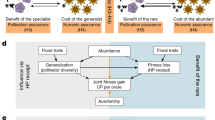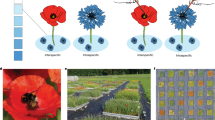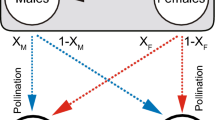Abstract
Since the theoretical paper of Levin and Anderson1, it has been widely recognised that animal pollinators represent resources for which plants can compete. Competition for pollination might take several forms and act as a powerful selective force in establishing or maintaining sequential flowering among sympatric species2. Sequential flowering in Arctic3, temperate4–9 and neotropical10–13 plant assemblages has been interpreted as an evolutionary result of competition for pollination. This interpretation may prove correct in many cases, although strong evidence for competition is available for few systems9,14. Heinrich and Raven15 (see also Baker16 and Baker et al.17) pointed out that sympatric plant species may act as mutualistic partners at the same time that their sequential flowering is maintained by competition. We develop this hypothesis here explicitly and present evidence that effective mutualism occurs between two species which also compete for pollination.
This is a preview of subscription content, access via your institution
Access options
Subscribe to this journal
Receive 51 print issues and online access
$199.00 per year
only $3.90 per issue
Buy this article
- Purchase on Springer Link
- Instant access to full article PDF
Prices may be subject to local taxes which are calculated during checkout
Similar content being viewed by others
References
Levin, D. A. & Anderson, W. W. Am. Nat. 104, 455–467 (1970).
Waser, N. M. Oecologia 36, 223–236 (1978).
Hocking, B. Oikos 19, 359–388 (1968).
Mosquin, T. Oikos 22, 298–402 (1971).
Reader, R. J. Can. J. Bot. 53, 1300–1305 (1975).
Heinrich, B. Ecology 57, 890–899 (1976).
Lack, A. New Phytol. 77, 787–792 (1976).
Parrish, J. A. D. & Bazzaz, F. A. Oecologia 35, 133–140 (1978).
Waser, N. M. Ecology 59, 934–944 (1978).
Heithaus, E. R. Ann. Mo. Bot. Gdn 61, 675–691 (1974).
Frankie, G. W., Baker, H. G. & Opler, P. A. J. Ecol. 62, 881–913 (1974).
Feinsinger, P. Ecol. Monogr. 48, 269–287 (1978).
Stiles, F. G. Science 198, 1117–1178 (1977).
Pleasants, J. thesis Univ. California (1977).
Heinrich, B. & Raven, P. H. Science 176, 597–602 (1972).
Baker, H. G. Science 139, 877–883 (1963).
Baker, H. G., Cruden, R. W. & Baker, I. Bioscience 21, 1127–1129 (1971).
Müller, H. The Fertilisation of Flowers (Macmillan, London, 1883).
Fleming, R. C. Michigan Ent. 3, 17–23 (1970).
Procter, M. & Yeo, P. The Pollination of Flowers (Taplinger, New York, 1972).
Richards, K. thesis, Univ. Kansas (1975).
Cody, M. L. Condor 70, 270–271 (1968).
Gill, F. & Wolf, L. L. Ecology 56, 333–345 (1975).
Gass, C. L., Angehr, G. & Centa, J. Can. J. Zool. 54, 2046–2054 (1976).
Kodric-Brown, A. & Brown, J. Ecology 59, 285–296 (1978).
Calder, W. A. Wilson Bull. 85, 283–290 (1973).
Waser, N. M. Condor 78, 133–135 (1976).
Author information
Authors and Affiliations
Rights and permissions
About this article
Cite this article
Waser, N., Real, L. Effective mutualism between sequentially flowering plant species. Nature 281, 670–672 (1979). https://doi.org/10.1038/281670a0
Received:
Accepted:
Issue Date:
DOI: https://doi.org/10.1038/281670a0
This article is cited by
-
Co-flowering modularity and floral trait similarity help explain temporal changes in plant–pollinator network structure
Plant Ecology (2022)
-
Climate warming–driven phenological shifts are species-specific in woody plants: evidence from twig experiment in Kashmir Himalaya
International Journal of Biometeorology (2022)
-
Flowering patterns change along elevational gradients and relate to life-history strategies in 29 herbaceous species
Alpine Botany (2020)
-
Temporally dependent pollinator competition and facilitation with mass flowering crops affects yield in co-blooming crops
Scientific Reports (2017)
-
Temporal niche overlap and distinct bee ability to collect floral resources on three species of Brazilian Malpighiaceae
Apidologie (2017)
Comments
By submitting a comment you agree to abide by our Terms and Community Guidelines. If you find something abusive or that does not comply with our terms or guidelines please flag it as inappropriate.



